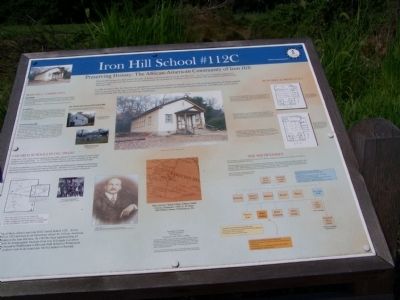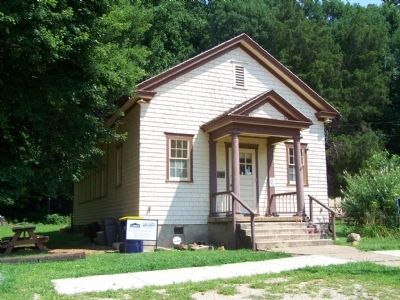Near Newark in New Castle County, Delaware — The American Northeast (Mid-Atlantic)
Iron Hill School #112C
Preserving History: The African-American Community of Iron Hill
The Iron Hill Museum is dedicated to the study of human and natural history of the Iron Hill Area. The Museum is currently engaged in a project to restore the Iron Hill School #112C and document the experiences of African-American students who attended the school between 1923 and 1965.
In order to achieve this, the Museum has embarked on an oral history project to formally interview and record the memories of former students who are now between the ages of 40 and 80. Oral historian Roberta Perkins, and Museum Director Laura Lee, are leading this project. It has received funding from the Delaware Heritage Commission.
Iron Hill Community
Beginnings:
In 1873 William McConaughey purchased land on Iron Hill to set up an ore mine. He hired immigrants and African-Americans to work in the mines. These workers and their families continued to live on the south face of the hill after the ore ran out in 1891.
(James R. And James B. Owens "A history of the Iron Hill area Newark, DE.")
Families:
Close-knit and self-sufficient families interacted mainly among themselves and their immediate community. They rarely strayed from Iron Hill except to work or shop. Residents often spent their time keeping track of one another. For example, Mr. Robert Grinnage, a former Iron Hill student said: "That's the way it would go, and if something (bad) would happen they would tell someone else and the next thing you knew everybody knew it."
Pastimes in Iron Hill:
Families enjoyed listening to the radio, attending dances and socials at the school, and playing games, some of these were hide-and-go-seek, hop-scotch, blind-man's bluff, crack-the-whip, king of the hill, jacks and cards. But baseball was probably the most popular game. "Baseball to me was a can and a stick off the tree. That type of thing. There is a word they use today - 'innovation'." said former student Mrs. Lena Satchell Dyer. She explained, "being a child in a small community like that molded me to be the type of person that I am now: To accept what I see, fix what I can fix - what I can't fix, accept it".
The Church was central to life in Iron Hill
Many people attended the nearby Saint Daniel's and Welsh Tract Churches where candle-light services were very popular.
[photo caption] St. Daniel's Church
Photograph courtesy of group member Erica Kowal.
[photo caption] Welsh Tract Church
Photograph courtesy of group member Dave Karge. [Same credit used for school photo at top center of this plaque.]
Colored Schools in Delaware
In the early
1900's Delawareans realized that the public schools for African-Americans were in bad condition and needed help. In 1919, Pierre Samuel duPont resigned as president of his family business and decided to use his own money to have these schools in the state rebuilt or renovated.
P.S. duPont established a two-million dollar trust fund for remodeling some existing school buildings, replacing some and constructing new ones in Delaware. Between 1919 and 1928 duPont personally financed the construction of more than 80 schools for African-American students in Delaware.
One of these schools was Iron Hill Colored School 112C. It was built in 1923 and used as an elementary school for African-American children in the Iron Hill area. In 1965 the State legislated that all schools be desegregated. Students from Iron Hill grade 6 and above were bussed to Middletown or Howard High School in Wilmington. Some students went to the brand new McVey School in Newark.
Lessons at Iron Hill included arithmetic, cursive writing, spelling and Bible verses. Former student Mary Burke recalled how a typical day began: "We would pray, and then say the pledge, and then we got down to homework". The teacher would work with one grade at a time, beginning with 1st and working her way all the way up before starting over.
Many students spoke of a particular lunchtime tradition. Donald Lewis explained. "Some of the kids weren't fortunate enough to bring lunch so they would bring a big old potato and put it up on the big old pot-bellied stove there in the morning and by lunch time it was done. then we had a hot plate that girls used to cook like macaroni. I never will forget that macaroni".
On Field Day, Iron Hill students competed against other African-American schools in track, baseball and dodge ball. Robert Grinnage remembered these annual events: "Years ago they used to have parades and everything and the kids would be all out of step marching of course with a band. There was something to look forward to".
Erected by Pencader Heritage Area Association.
Topics. This historical marker is listed in these topic lists: African Americans • Education • Settlements & Settlers • Sports. A significant historical year for this entry is 1923.
Location. This marker has been replaced by another marker nearby. It was located near 39° 38.462′ N, 75° 43.941′ W. Marker was near Newark, Delaware, in New Castle County. Marker was on Dayett Mill Road south of Old Baltimore Pike, on the right when traveling south. Touch for map. Marker was at or near this postal address: 934 Dayett Mill Rd, Newark DE 19702, United States of America. Touch for directions.
Other nearby markers. At least 8 other markers are within walking distance of this location. The Battle of Cooch’s Bridge (here, next to this marker); In the Beginning … (here, next to this marker); Delaware's Field of Valor (here, next to this marker); Enjoy the Pencader Area Today (here, next to this marker); Geology (here, next to this marker); Mason Dixon Line & the Boundaries of Delaware (here, next to this marker); Your Gateway to Pencader Heritage (here, next to this marker); Milling in Pencader Hundred (here, next to this marker). Touch for a list and map of all markers in Newark.
More about this marker. Marker contains photos, diagrams and a family tree.
Written 26 September 2020: Could not find this marker at this location, but it might occur elsewhere. (Try 1355 Old Baltimore Pike.)
Also see . . . Iron Hill Museum. Iron Hill School #112c has been a natural history museum since 1968 when the Delaware Academy of Science received the school and the two acres around it from the Newark School District. In addition to programs about the natural history of the area, the Museum tells the story of the building of 91 schools through out Delaware for African Americans by P.S. du Pont in the 1920's. (Submitted on September 22, 2009, by Director, Iron Hill Museum of Newark, Delaware.)
Credits. This page was last revised on December 31, 2023. It was originally submitted on August 7, 2008, by Bill Pfingsten of Bel Air, Maryland. This page has been viewed 3,025 times since then and 21 times this year. Last updated on October 21, 2020, by Carl Gordon Moore Jr. of North East, Maryland. Photos: 1, 2. submitted on August 7, 2008, by Bill Pfingsten of Bel Air, Maryland.

